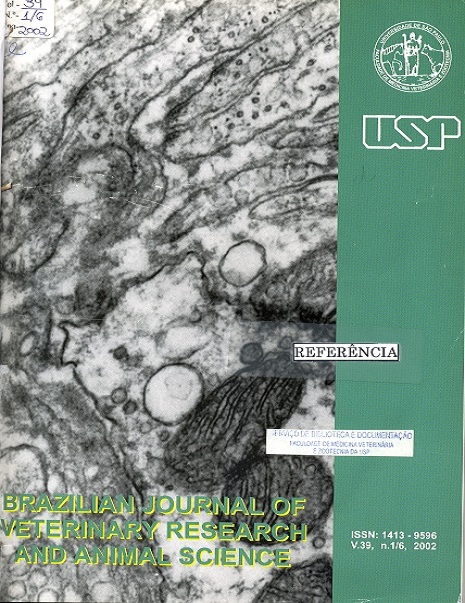Inquiry of cases of myiasis by Cochliomyia hominivorax in cats of the northern, southern, western and central zones of Rio de Janeiro municipality in 2000
DOI:
https://doi.org/10.1590/S1413-95962002000400001Keywords:
Cat, Myiasis, Cochliomyia hominivorax, Screwworm, InquiryAbstract
An inquiry about the cases of myiasis by Cochliomyia hominivorax larvae in cats presented to 227 veterinary establishments of the Northern, Southern, and Western Zones of Rio de Janeiro municipality in 2000 was performed, to identify predisposing factors and to contribute to the comprehension of the epidemiological features of this parasitic disease. In one hundred and fifty two establishments, at least one case of myiasis by C. hominivorax larvae in cats was presented, and dogs were most infested than cats. Incidence was higher in hot weather months or periods of the year: January, February, November, and December. Adult, dark and short-haired, intact males, and mixed-breeding cats were the most affected. Because myiasis by C. hominivorax larvae are often in Rio de Janeiro City, as concluded in this inquiry, and it is not necessary to report the cases to authorities, a lot of clinicians did not consider it as a disease of great importance. Preventive programs against screwworm infestation should be developed according to identified predisposing factors, such as phenotypic features of infested animals (breed, hair color, hair size, sex, and age) and months of highest incidence, when programs should be intensified. Pet owners should be warned by veterinary clinicians about harm caused by myiasis and should receive directions about preventive rules, including maintenance of environment hygiene and avoidance of more common myiasis causes.Downloads
Download data is not yet available.
Downloads
Published
2002-01-01
Issue
Section
UNDEFINIED
License
The journal content is authorized under the Creative Commons BY-NC-SA license (summary of the license: https://
How to Cite
1.
Cramer-Ribeiro BC, Sanavria A, Oliveira MQ de, Souza FS de, Rocco F da S, Cardoso PG. Inquiry of cases of myiasis by Cochliomyia hominivorax in cats of the northern, southern, western and central zones of Rio de Janeiro municipality in 2000. Braz. J. Vet. Res. Anim. Sci. [Internet]. 2002 Jan. 1 [cited 2024 Jul. 26];39(4):165-70. Available from: https://www.revistas.usp.br/bjvras/article/view/5961





